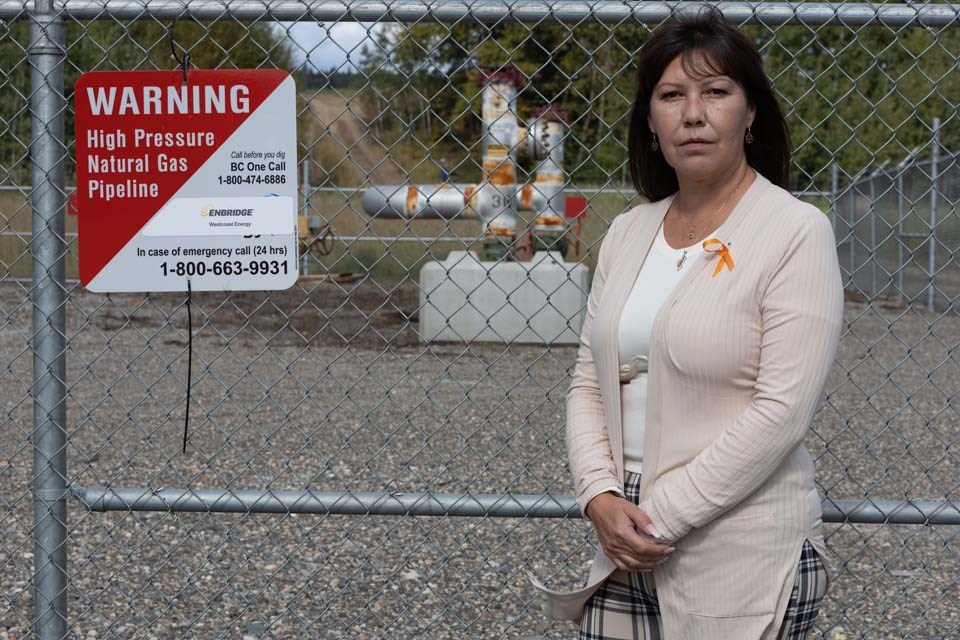The Lheildi T’enneh First Nation is seeking a ministerial order to re-route Enbridge’s on-reserve natural gas pipeline off their reserve on the basis of public safety and reconciliation.
In a press conference this morning (Sept. 14) the Nation announced it has taken inspiration from a legal maneuver from the Unites States.
In November of 2020, Michigan Governor Gretchen Whitmer notified Enbridge that the state was revoking and terminating the 1953 easement allowing a pipeline to sit on the bottom of the Straits of Mackinac, the stretch of water which connects lake Michigan and Lake Huron.
This action was taken on the basis that the easement was in violation of the public trust doctrine, given the unreasonable risk that continued operation of the dual pipelines poses to the Great Lakes.
The Nation says that to date, Enbridge has done nothing to address valid safety concerns relating to the massive fireball explosion which occurred on Oct. 9, 2018.
While no one was hurt in the event, Lheidli T’enneh has said it left some members with heightened anxiety and trauma.
“It was a very scary time for our members. I will never forget that day,” said Elder Phyllis Seymour during the press conference.
“We want that pipeline to be moved so our members can sleep better at night knowing they are going to be safe. Nothing is impossible. I want them to know this was trauma to our reserve and our membership.”
In its lawsuit filed Feb. 27, 2019, Lheidli T’enneh is seeking damages from Enbridge for the explosion and wants the court to force the Calgary-based company to remove its pipelines from its unceded ancestral lands.
Westcoast Energy, an Enbridge subsidiary, was also issued a $40,000 fine from the Transportation Safety Board for failing to prevent the blast.
In March 2019, Enbridge met with the Lheidli T’enneh band council and proposed an out-of-court settlement, which was rejected. The First Nation stated the offer was “disrespectful, pitiful, and failed to provide required safety assurances to the community.”
Lheidli T’enneh has now sent a letter to the provincial and federal governments requesting a ministerial order which would force the company to relocate its pipeline away from reserve lands.
The Enbridge Pipeline presently traverses approximately 130 kilometers of Lheildi T’enneh territory and 1.5 kilometers of the Fort George No. 2 Indian Reserve.
The western boundary of Fort George No. 2 Indian Reserve lies approximately 500 meters from the site of the explosion.
The Enbridge Pipeline is crossed daily by residents living on reserve, including the local school bus.
“Our court case against Enbridge could take years to resolve. Enbridge requested last year that we negotiate a settlement. However, Enbridge has offered nothing of substance in the way of proper emergency safety planning and oversight,” said Chief Dolleen Logan.
“For example, LTFN asked Enbridge to do the right thing and build a bridge across the river which separates our reserve, allowing our north side reserve residents a way to leave the reserve in the event of a future Enbridge pipeline explosion. Enbridge refused, stating it was too costly. Meanwhile, Enbridge makes hundreds of millions a year carrying hydrocarbons through our reserve and territory.”
Logan said she doubts Enbridge’s safety record after an Aug. 2019 Enbridge Pipeline explosion in Junction City, Kentucky killed a woman.
It also damaged structures within 450 metres, including destroying at least five homes and railroad tracks and forcing the evacuation of a nearby mobile home park.
“Enbridge prioritizes corporate profit over human lives, and certainly over our Indigenous lives. No amount of money is worth the human safety risk our community bears. We don’t trust Enbridge transporting hydrocarbons through our reserves. Neither do many of our Indigenous neighbours, who have written letters of support for our lawsuit against Enbridge.”
The Lheidli T’enneh First Nation’s laywer Malcolm Macpherson said the Nation experienced pandemonium during the Oct. 9 explosion.
“What the Lheidli T’enneh are proposing through the requested re-routing of the Enbridge pipeline off of their reserve is a win-win resolution for both LTFN and Enbridge. Following a re-route, Enbridge would continue to transport hydrocarbons to refineries in the Pacific Northwest, without having to invest in much needed safety infrastructure on LTFN’s Fort George No. 2 Indian Reserve,” said Macperson.
“The win in it for LTFN is they achieve peace of mind knowing that their members and school bus don’t have to drive over a pipeline on a daily basis which left a moon sized crater in their backyard.”
In a statement following the Nation’s announcement, Enbridge said it is committed to continuing to work with leadership to strengthen its relationship with the Lheidli T’enneh First Nation.
“Following the Shelley incident, we undertook a comprehensive pipeline integrity program on our natural gas pipeline system in B.C. to significantly improve pipeline safety. This was the most aggressive integrity program ever undertaken in B.C. It included increased pipeline inspections, enhanced criteria to evaluate pipeline inspection data and improvements to the scheduling of proactive maintenance work. At Enbridge, our goal is to continuously improve the safety of our pipeline systems and we are committed to ensuring that happens,” stated the company.
“As always, we are happy to meet with the Lheidli T’enneh First Nation or any government agency to discuss the safety of the pipeline system or any other matter, including the small segments of pipeline that traverse their reserve.”
Lheidli T’enneh sent letters to Katrine Conroy the Minister of Lands, Forest, National Resource Operations and Carolyn Bennett Minister of Crown-Indigenous Relations.
Macpherson stated that the request was sent to both ministers as both levels of government would need to work together to reroute the pipeline.





